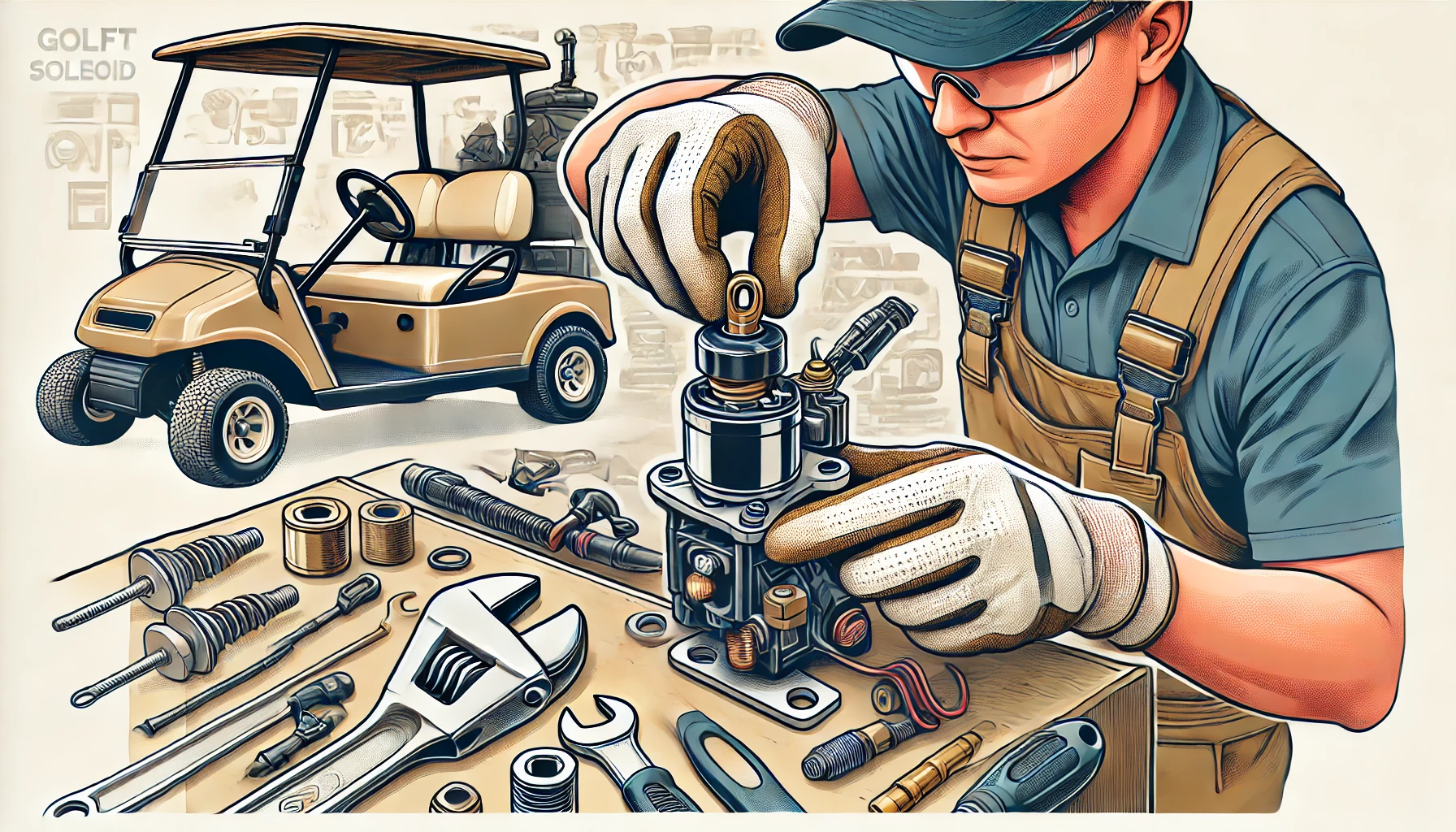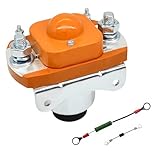Many of us who enjoy playing golf depend on golf carts. Maintaining the condition of your golf cart is crucial whether you run errands in your neighborhood or zip about the course. The solenoid is one important element that sometimes requires maintenance. Knowing how to replace a golf cart solenoid can help you save money and time as well as keep your cart in perfect running order. Let’s get into the specifics of replacing a golf cart solenoid, methodically.
Understanding the Solenoid
What is a Solenoid?
A solenoid in a golf cart acts like an electrical switch. It allows power from the battery to reach the motor when you press the accelerator. Without it, your cart wouldn’t move. It’s a crucial part of the electrical system, whether you have an electric or gas golf cart.
Understanding Different Types of Solenoids
Electric vs. Gas Golf Cart Solenoids
Electric: Usually including a solenoid as a switch to run the electricity from the battery to the engine, electric golf carts The cart depends on these solenoids since they are made to manage enormous current loads and are essential for their flawless running. Their increased number of electrical components involved makes them usually more complicated.
Gas: Solenoids are frequently found in the starter circuit of gas-powered golf carts to engage the starting motor. Although they help to control electrical flow, the solenoids in gas carts are often simpler and manage different electrical requirements than those in electric carts.
Typical Mistakes to Avoid During Diagnosis
Verify it is in fact the faulty component before replacing the solenoid. Sometimes problems with wiring or inadequate battery performance could resemble solenoid failure symptoms. Testing the solenoid with a multimeter will help to prevent needless replacements.
Incorrect installation
Follow Installation Guidelines exactly: incorrect installation could harm the new solenoid or other golf cart component. Pay great attention to wiring connections and mounting placements and carefully follow the detailed instructions.
Solenoid Troubleshooting Guide
What should I do if the cart still doesn’t start?
Check for Faulty Wiring: Inspect every electrical connection to make sure they are free from corrosion or damage and secure. Inappropriate solenoid performance might be caused by loose or broken wires.
Verify Compatibility: Check to be sure the new solenoid fits your particular golf cart model. Using an incompatible solenoid may cause more problems and maybe damage other parts.
Solenoid Performance and Longevity
Factors Affecting Solenoid Lifespan
Frequency of Use: Solenoid wear and tear increases with increasing frequency of operation for your golf cart. Periodic checks and maintenance help to increase the lifetime of a product.
Environmental Factors: Solenoid function might be adversely affected by extreme temperatures, humidity, water or soil exposure. Whenever at all feasible, keep your golf cart and its parts free from extreme environmental conditions.
Signs You Need to Replace the Solenoid
Common Symptoms of a Faulty Solenoid
Before learning how to replace a golf cart solenoid, you need to know the signs of a failing one:
- Clicking Sound but No Movement: If you hear a click when you press the accelerator but the cart doesn’t move, the solenoid might be faulty.
- Intermittent Starting Issues: Your cart starts sometimes but not always.
- Complete Failure to Start: The cart doesn’t start at all, even though the battery is charged.
[Check out our complete guide on how to test golf cart solenoid here]
I remember the first time my cart wouldn’t start. I was all set for a day on the course, but all I got was a frustrating click. After some investigation, I discovered it was the solenoid.
Tools and Materials Needed
Essential Tools
To replace a golf cart solenoid, you’ll need:
- Wrenches
- Screwdrivers
- Multimeter (for testing purposes)
- Safety Gloves and Goggles
Replacement Solenoid
It’s important to get the right solenoid for your specific golf cart model. Check your cart’s manual or consult with a supplier to ensure you get the correct part. You can find a top selling model on Amazon here.
- 36 Volt 4 terminal SPNO heavy-duty solenoid for EZGO TXT, Medalist, Marathon 1971-2010 electric golf cart
- Replaces part#: 70-120224, 11761GA, 11761-G1, 27855-G01, 27855G01, 27805-G02, 27805G02, 31680-G1, 31680G1, 3016, Cole Hersee 24080
- 4 Terminal 12 volt solenoid for 1984-up Club Car DS and 2004-up Club Car Precedent gas golf carts
- Replaces part number: 1013609, 1012275, 435-154, 1117, LPL6003
- 1. Model: EZGO TXT 48V solenoid for electric 2010-UP and all 48V MPT 800/1000 Vehicles golf cart, OEM# 612711.
- 2. Skills: Silver contacts help improve product efficiency and service life.
- Part Number: MZJ-400A
- Compatible With Heavy Duty Golf Cart
- 48V 4-Terminal Solenoid with Resistor for Club Car golf cart
- Fits electric Club Car DS 1995-up, Club Car Precedent 2000-up
Preparing for Replacement
Safety Precautions
Safety first! Before you start, make sure to:
- Disconnect the Battery: This prevents any accidental shocks.
- Wear Protective Gear: Gloves and goggles are a must.
Locating the Solenoid
Solenoids are typically found near the battery pack or under the seat. In gas golf carts, they might be near the starter. Refer to your cart’s manual for the exact location.
Step-by-Step Guide to Replacing the Solenoid
Step 1: Disconnect the Battery
Disconnect the battery to prevent any electrical mishaps before you start anything else. Replacing a golf cart solenoid depends critically on this stage.
Step 2: Remove the Old Solenoid
- Locate the Solenoid: Look for the solenoid. Determine the solenoid depending on your cart style.
- Detach the Wires: Remove the wires linked to the solenoid with a wrench or screwdriver. Recall the wire’s sequence or snap a picture for your records.
- Remove Mounting Bolts: Use your wrench to remove the bolts securing the solenoid in position.
Step 3: Install the New Solenoid
- Position the New Solenoid: Orient the new solenoid where the previous one was installed.
- Attach the Wires: Connect the wires to the new solenoid in the proper sequence. Verify their tightness and security.
- Secure the Solenoid: Use the bolts to fix the new solenoid in position.
Step 4: Reconnect the Battery
Reconnect the battery once the new solenoid is mounted. Check that every link is secure and tight.
Testing the New Solenoid
Initial Tests
After replacing the solenoid, it’s time to test it:
- Turn on the Cart: Press the accelerator and see if the cart moves.
- Listen for Clicks: A healthy solenoid will make a clicking sound when you press the accelerator.
Troubleshooting Common Issues
If the cart doesn’t start after you’ve replaced the solenoid:
- Check Connections: Ensure all wires are connected properly.
- Test the Battery: Make sure the battery is charged.
- Double-Check the Solenoid: Use a multimeter to test the new solenoid if necessary.
Tips for Maintaining Your Solenoid
Regular Maintenance Tips
To avoid future problems:
- Periodic Checks: Regularly inspect the solenoid for signs of wear or damage.
- Clean Connections: Keep the connections clean and free of corrosion.
Signs of Wear and Tear
Over time, even the best-maintained solenoids can fail. If you notice:
- Burn Marks: Indicate electrical issues.
- Corroded Terminals: These can affect the solenoid’s function.
- No Click Sound: When you press the accelerator, it’s time to consider a replacement.
Expert Assistance vs. DIY
When Should One Consult a Professional?
Complex Problems: See a professional if your golf cart has complicated electrical difficulties or if you are not sure about the diagnosis. They can offer a correct diagnosis and effective fixing.
Lack of Tools or Experience: The best course of action is to consult a professional if you do not have the required tools or feel awkward substituting yourself. This guarantees appropriate and safe performance of the work.
Commonly Asked Questions (FAQs)
What differs in a solenoid from a relay? While a relay is an electrical switch opened and closed under the direction of another electrical circuit, a solenoid is an electromagnetic switch used to handle high current circuits. Usually utilized in golf carts, solenoids’ capacity to manage greater currents makes sense.
How often should a solenoid be replaced? Use and environmental conditions determine the replacement frequency. Frequent maintenance inspections can help find a solenoid approaching the end of its lifetime.
Does a solenoid change the speed of my golf cart? Indeed, the speed and performance of your golf cart can suffer from a defective solenoid. Should the solenoid not be providing enough power to reach the motor, the cart can operate slower than usual.
Additional Golf Cart Battery Resources
- How to Test a Golf Cart Solenoid
- How Many Batteries Does a Golf Cart Take: The Complete Guide
- How to Test Golf Cart Batteries: The Complete Guide
- How Much Are Golf Cart Batteries?
- How Long Does It Take to Charge a Golf Cart: Complete Guide
- How Long Do Golf Cart Batteries Last?
- Golf Cart Battery Water: Complete Maintenance Guide
Affiliate Link Disclaimer: Our website may contain affiliate links, which means we may earn a commission if you make a purchase through these links. This comes at no additional cost to you. We only recommend products or services that we believe will add value to our readers.






